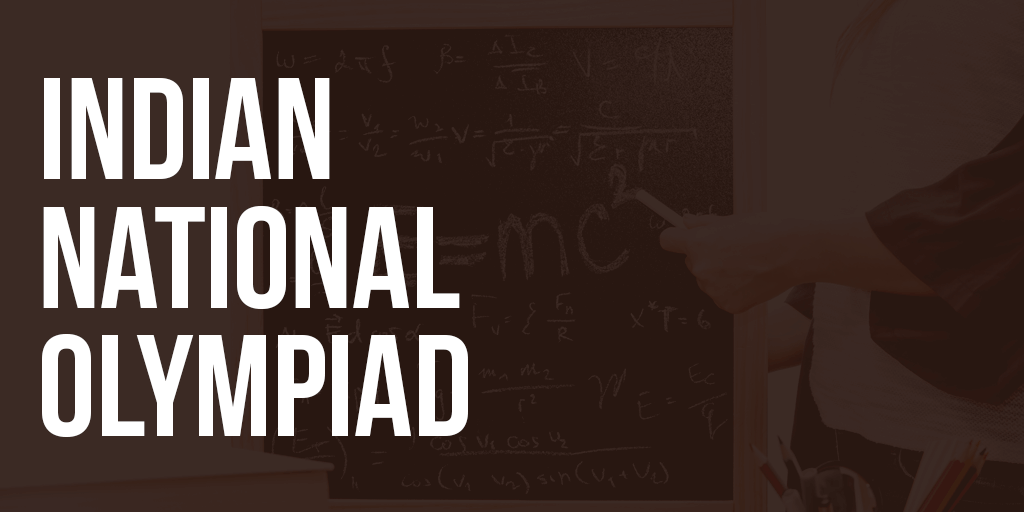The Indian National Olympaid (INO) is the second stage of the selection process, for the International Science Olympiads in the respective subjects. It is organised by the HBCSE. This examination is held at about 18 centres across the country.

Indian National Olympiad
Indian National Olympiad
You can get in touch with your school Headmaster to check whether your school is a NSE centre. If, yes then you can directly pay the fees and your school would be given the required guidance pertaining to the NSE.
If your school/college is not a registered centre, then you could visit the website: www.iapt.org.in. The website would display the details of the registered centre for last year. This might help you to locate the nearest centre you and enrolling your name at the centre by paying the required fee.
- Fee: Rs.100 per student
- The fees are payable to the centre in-charge of the centre where you have enrolled your name. No direct remittance to IAPT is permissible.
- No TA/ DA is admissible for NSE (Stage I Examination).
You can register for the INO by logging in with your NSE Centre code, NSE Roll number and your date of birth. You would be able to login only if you have qualified for the INO. In case you are not able to login you can contact the INO conducting authority and get it rectified by providing your name, NSE Centre Code, Roll no. and date of birth.
Important Dates for INO
| Mandatory Registration on the INO Website | 2th January – 13th January 2018 |
| Hall tickets dispatched by email and available on INO website for download | Mid January |
| Question Paper and provisional solutions on the INO Website | Last week of January |
| Comments on the provisional solutions on the HBCSE website | First week of February |
| Frozen solutions on the HBCSE Website | Mid February |
| Scores available on INO website | Mid February |
| Re-evaluation request (through INO Website) | 3rd week of February |
| Final Scores, Certificate and OCSC List | Last week of February |
INO Tentative dates:
| Exam | Date (Tentative) |
| Indian National Astronomy Olympiad (INAO) | Last week of January |
| Indian National Junior Science Olympiad (INJSO) | Last week of January |
| Indian National Chemistry Olympiad (INChO) | Last week of January |
| Indian National Physics Olympiad (INPhO) | Last week of January |
| Indian National Biology Olympiad (INBO) | Last week of January |
Syllabus

It is broadly equivalent to senior secondary level (up to and including Class XII) of CBSE. The syllabus varies depending upon the examination you wish to appear. Likewise, the syllabus for the INPhO will include questions broadly from Physics and there would be a few add-ons in terms of Mathematics. This remains true for all the other science olympiads. The difficulty level of the question increases with the further stages though essentially syllabus remains more or less the same.
Click on the link below to have an insight into the syllabus:
Selection Process
The aim of the first stage examination is to have a wide reach, to progressively increase this reach and to attain nationwide representation for Stage II without overly compromising on merit. Hence the selection for the Stage II examinations, i.e., Indian National Olympiad Examinations (INOs) is based on the following scheme.
- Eligibility Clause:
To be eligible for the Stage II INO exam leading to the International Olympiad, a candidate must secure a score equal to or greater than a Minimum Admissible Score (MAS). The MAS for a given subject will be 50% of the average of the top ten scores in that subject rounded off to the nearest lower integer
2. Merit Index Clause:
There will be a high score called the Merit Index (MI) associated with each subject in Olympiads. The MI in a subject is defined as 80% of the average of the top ten scores in that subject rounded off to the nearest lower integer. All students with a score equal to or greater than merit index MI for the subject will automatically qualify for INO Stage II examination in that subject. For example, if the average of top ten scores in a certain subject is 92, then 80% of this is 73.6. Then the MI in that subject will be 73. All candidates with a score equal to or above 73 in that subject will automatically qualify for INO stage II.
3. Proportional Representation Clause
Students from all States and UTs need to be encouraged to appear for the first stage examination and a nationwide representation for INO Stage II is desirable. The quota for each State/UT used in National Talent Search Examination (NTSE) 2013-14, a nationwide competitive examination will be used as the baseline for calculating the number of students qualifying for Stage II INO in every subject from centres in that State or UT. Suppose the NTSE quota is S for a State, and the total for all States and UTs is T, then the total number of students to be selected to INO Stage II from that State would be S/T times 300, rounded off to the nearest higher integer. This number will include those selected on the basis of the Merit Index. In the event of tie at the last position in the list, all students with same marks at this position will qualify to appear for the INO Stage II examination. The selected students must nevertheless satisfy the eligibility clause. The number to be selected from all the centres in each Stage or UT will be displayed on the IAPT and HBCSE websites.
4. Minimum Representation Clause:
Notwithstanding the proportional representation clause the number of students selected for the INO from each State and UT must be at least 1, provided the eligibility criterion is satisfied.
Admit Card
The admit card for the INO is released just a few days before the examination. The admit cards would be mailed to the candidates who have provided their e-mail IDs during the registration process. You must download the admit card and keep it with you on the day of the examination. You can download the INO Admit card from here.
Result

The score card is now available for download on the INO Website. You can access your result by logging in with your Roll number and date of birth. Click here to download your result.
Examination Centres (Year 2016-17)
| City | Centre Coordinator | Examination Centre |
| Ahmedabad | Prof. Tushar C. Pandya | St. Xavier’s College, Navrangpura, Ahmedabad, Gujarat – 380 051 |
| Bengaluru | Dr. Rekha S. | V.V.S. First Grade College, Mangaladhama, II Block, III Stage, Near Canara Bank, Basaveshwaranagar, Bengaluru, Karnataka – 560 079 |
| Bhopal | Dr. Sukanta Panda | Indian Institute of Science Education and Research Bhopal, Indore Bypass Road, Bhauri, Bhopal, Madhya Pradesh – 462 023 |
| Bhubaneswar | Prof. Raj Mohan Mohanty | B.J.B. Junior College, District Khurda, Bhubaneswar, Odisha (Orissa) – 751 014 |
| Chandigarh | Prof. C. N. Kumar | Dept. of Physics, Panjab University, Sector 14, Chandigarh, Chandigarh – 160 014 |
| Chennai | Prof. V. V. Sreedhar | Chennai Mathematical Institute, Plot H 1, Sipcot IT Park, Siruseri, Kelambakkam, Chennai, Tamil Nadu – 603 103 |
| Delhi | Prof. Ravi S. Bhattacharjee | SGTB Khalsa College, University of Delhi, Delhi, Delhi – 110 007 |
| Guwahati | Prof. Dilip Pal | Department of Physics, Indian Institute of Technology Guwahati,, Guwahati, Guwahati, Assam – 781039 |
| Hyderabad | Mr. K. Mahapatra | Atomic Energy Central School 2, D. A. E. Colony, E. C. I. L. Post, Hyderabad, Telangana – 500 062 |
| Jaipur | Ms. Mala Agnihotri | India International School, Kshipra Path, Opposite V.T. Road, Mansarovar, Jaipur, Rajasthan – 302 020 |
| Kolkata | Dr. Bhupati Chakrabarti | Patha Bhavan (Secondary Section), 103 A & C Ballygunge Place, Kolkata 700019, West Bengal – 700 032 |
| Kochi | Prof. James Joseph | St. Albert’s High School, Banerji Road, Ernakulam, Kochi, Kerala – 682 017 |
| Kota | Dr. Shanker Lal Sharma | Bhuvnesh Bal Vidyalaya, Kota-Baran National Highway, Kota, Rajasthan – 324 001 |
| Lucknow | Prof. Udit Gupta | City Montessory Inter College, Vishal Khand II, Gomati Nagar, Lucknow, Uttar Pradesh – 226 024 |
| Mumbai | Prof. Anwesh Mazumdar | Homi Bhabha Centre for Science Education, V. N. Purav Marg, Mankhurd, Mumbai, Maharashtra – 400 088 |
| Nagpur | Dr. Vijay V. Soman | National Fire Service College, Takli Feeder Road, Near Police Talaw T-Junction, (Near Mental Hospital), Raj Nagar, Nagpur, Maharashtra – 440022 |
| Patna | Dr. Himanshu Pandey | Bishop Scott Girls School, Brahmpur, Jaganpura, New Bypass Road Road, Lane next to Patna Central School , Kankarbagh, Patna, Bihar – 800 001 |
| Ranchi | Mr. Ajay Kumar Singh | Jawahar Vidya Mandir, Shyamali Colony, Doranda, Ranchi, Jharkhand – 834 002 |
INO Previous Year’s Papers
| Subjects | Question Papers | Solutions |
| Physics | Physics – Question Paper with Solutions – 2017 | Physics – Question Paper with Solutions – 2017 |
| Chemistry | Chemistry – Question Paper – 2017 | Chemistry – Solution – 2017 |
| Biology | Biology – Question Paper – 2017 | Biology – Solution – 2017 |
| Junior Science | Junior Science – Question Paper – 2017 | Junior Science – Solution – 2017 |
| Astronomy | Astronomy – Question Paper with Solution – 2017 | Astronomy – Question Paper with Solution – 2017 |

